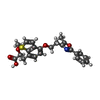[English] 日本語
 Yorodumi
Yorodumi- PDB-3g8i: Aleglitazar, a new, potent, and balanced PPAR alpha/gamma agonist... -
+ Open data
Open data
- Basic information
Basic information
| Entry | Database: PDB / ID: 3g8i | ||||||
|---|---|---|---|---|---|---|---|
| Title | Aleglitazar, a new, potent, and balanced PPAR alpha/gamma agonist for the treatment of type II diabetes | ||||||
 Components Components |
| ||||||
 Keywords Keywords | TRANSCRIPTION/TRANSFERASE / NUCLEAR HORMONE RECEPTOR / TRANSCRIPTION FACTOR / DIABETES / Activator / DNA-binding / Metal-binding / Nucleus / Polymorphism / Receptor / Transcription / Transcription regulation / Zinc / Zinc-finger / Acyltransferase / Alternative splicing / Chromosomal rearrangement / Phosphoprotein / Proto-oncogene / Transferase / Ubl conjugation / TRANSCRIPTION-TRANSFERASE COMPLEX | ||||||
| Function / homology |  Function and homology information Function and homology informationpositive regulation of transformation of host cell by virus / regulation of fatty acid transport / enamel mineralization / negative regulation of cell growth involved in cardiac muscle cell development / positive regulation of fatty acid oxidation / regulation of fatty acid metabolic process / cellular response to fructose stimulus / regulation of cellular ketone metabolic process / behavioral response to nicotine / negative regulation of appetite ...positive regulation of transformation of host cell by virus / regulation of fatty acid transport / enamel mineralization / negative regulation of cell growth involved in cardiac muscle cell development / positive regulation of fatty acid oxidation / regulation of fatty acid metabolic process / cellular response to fructose stimulus / regulation of cellular ketone metabolic process / behavioral response to nicotine / negative regulation of appetite / lipoprotein metabolic process / positive regulation of fatty acid beta-oxidation / negative regulation of hepatocyte apoptotic process / mitogen-activated protein kinase kinase kinase binding / negative regulation of leukocyte cell-cell adhesion / labyrinthine layer morphogenesis / ubiquitin conjugating enzyme binding / regulation of thyroid hormone receptor signaling pathway / positive regulation of transcription from RNA polymerase II promoter by galactose / negative regulation of glycolytic process / positive regulation of female receptivity / negative regulation of sequestering of triglyceride / nuclear steroid receptor activity / DNA-binding transcription activator activity / hypothalamus development / nitric oxide metabolic process / positive regulation of fatty acid metabolic process / male mating behavior / NR1H2 & NR1H3 regulate gene expression to control bile acid homeostasis / positive regulation of ATP biosynthetic process / NFAT protein binding / negative regulation of cholesterol storage / negative regulation of macrophage derived foam cell differentiation / negative regulation of phosphatidylinositol 3-kinase/protein kinase B signal transduction / cellular response to Thyroglobulin triiodothyronine / estrous cycle / Synthesis of bile acids and bile salts / negative regulation of cytokine production involved in inflammatory response / epidermis development / phosphatase binding / Endogenous sterols / Synthesis of bile acids and bile salts via 27-hydroxycholesterol / Synthesis of bile acids and bile salts via 7alpha-hydroxycholesterol / positive regulation of lipid biosynthetic process / nuclear retinoid X receptor binding / Transcriptional regulation of brown and beige adipocyte differentiation by EBF2 / negative regulation of reactive oxygen species biosynthetic process / response to retinoic acid / histone acetyltransferase activity / Recycling of bile acids and salts / histone acetyltransferase / cellular response to hormone stimulus / negative regulation of signaling receptor activity / positive regulation of gluconeogenesis / MDM2/MDM4 family protein binding / NR1H3 & NR1H2 regulate gene expression linked to cholesterol transport and efflux / positive regulation of adipose tissue development / RORA activates gene expression / peroxisome proliferator activated receptor signaling pathway / negative regulation of blood pressure / positive regulation of neuron differentiation / lactation / Regulation of lipid metabolism by PPARalpha / hormone-mediated signaling pathway / cellular response to starvation / regulation of cellular response to insulin stimulus / cerebellum development / response to nutrient / BMAL1:CLOCK,NPAS2 activates circadian gene expression / SUMOylation of transcription cofactors / Activation of gene expression by SREBF (SREBP) / negative regulation of miRNA transcription / nuclear receptor coactivator activity / fatty acid metabolic process / gluconeogenesis / response to progesterone / nuclear receptor binding / hippocampus development / nuclear estrogen receptor binding / RNA polymerase II transcription regulatory region sequence-specific DNA binding / negative regulation of transforming growth factor beta receptor signaling pathway / circadian regulation of gene expression / wound healing / Heme signaling / SUMOylation of intracellular receptors / mRNA transcription by RNA polymerase II / response to insulin / Transcriptional activation of mitochondrial biogenesis / regulation of circadian rhythm / PPARA activates gene expression / Cytoprotection by HMOX1 / cerebral cortex development / transcription coactivator binding / DNA-binding transcription repressor activity, RNA polymerase II-specific / negative regulation of inflammatory response / Transcriptional regulation of white adipocyte differentiation / Nuclear Receptor transcription pathway / RNA polymerase II transcription regulator complex / nuclear receptor activity / male gonad development Similarity search - Function | ||||||
| Biological species |  Homo sapiens (human) Homo sapiens (human) | ||||||
| Method |  X-RAY DIFFRACTION / X-RAY DIFFRACTION /  MOLECULAR REPLACEMENT / Resolution: 2.2 Å MOLECULAR REPLACEMENT / Resolution: 2.2 Å | ||||||
 Authors Authors | Benz, J. / Bernardeau, A. / Binggeli, A. / Blum, D. / Boehringer, M. / Grether, U. / Hilpert, H. / Kuhn, B. / Maerki, H.P. / Meyer, M. ...Benz, J. / Bernardeau, A. / Binggeli, A. / Blum, D. / Boehringer, M. / Grether, U. / Hilpert, H. / Kuhn, B. / Maerki, H.P. / Meyer, M. / Puentener, K. / Raab, S. / Ruf, A. / Schlatter, D. / Gsell, B. / Stihle, M. / Mohr, P. | ||||||
 Citation Citation |  Journal: Bioorg.Med.Chem.Lett. / Year: 2009 Journal: Bioorg.Med.Chem.Lett. / Year: 2009Title: Aleglitazar, a new, potent, and balanced dual PPARalpha/gamma agonist for the treatment of type II diabetes. Authors: Benardeau, A. / Benz, J. / Binggeli, A. / Blum, D. / Boehringer, M. / Grether, U. / Hilpert, H. / Kuhn, B. / Marki, H.P. / Meyer, M. / Puntener, K. / Raab, S. / Ruf, A. / Schlatter, D. / Mohr, P. | ||||||
| History |
|
- Structure visualization
Structure visualization
| Structure viewer | Molecule:  Molmil Molmil Jmol/JSmol Jmol/JSmol |
|---|
- Downloads & links
Downloads & links
- Download
Download
| PDBx/mmCIF format |  3g8i.cif.gz 3g8i.cif.gz | 70.3 KB | Display |  PDBx/mmCIF format PDBx/mmCIF format |
|---|---|---|---|---|
| PDB format |  pdb3g8i.ent.gz pdb3g8i.ent.gz | 51.4 KB | Display |  PDB format PDB format |
| PDBx/mmJSON format |  3g8i.json.gz 3g8i.json.gz | Tree view |  PDBx/mmJSON format PDBx/mmJSON format | |
| Others |  Other downloads Other downloads |
-Validation report
| Arichive directory |  https://data.pdbj.org/pub/pdb/validation_reports/g8/3g8i https://data.pdbj.org/pub/pdb/validation_reports/g8/3g8i ftp://data.pdbj.org/pub/pdb/validation_reports/g8/3g8i ftp://data.pdbj.org/pub/pdb/validation_reports/g8/3g8i | HTTPS FTP |
|---|
-Related structure data
| Related structure data | 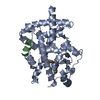 3g9eC  1k71 C: citing same article ( S: Starting model for refinement |
|---|---|
| Similar structure data |
- Links
Links
- Assembly
Assembly
| Deposited unit | 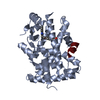
| ||||||||
|---|---|---|---|---|---|---|---|---|---|
| 1 |
| ||||||||
| Unit cell |
|
- Components
Components
| #1: Protein | Mass: 30571.697 Da / Num. of mol.: 1 / Fragment: Ligand bind domain Source method: isolated from a genetically manipulated source Source: (gene. exp.)  Homo sapiens (human) / Gene: PPARA, NR1C1, PPAR / Plasmid: PET15B / Production host: Homo sapiens (human) / Gene: PPARA, NR1C1, PPAR / Plasmid: PET15B / Production host:  |
|---|---|
| #2: Protein/peptide | Mass: 1660.912 Da / Num. of mol.: 1 / Fragment: motif 5 / Source method: obtained synthetically Details: THE PEPTIDE WAS CHEMICALLY SYNTHESIZED. THE SEQUENCE OF THE PEPTIDE IS NATURALLY FOUND IN HOMO SAPIENS (HUMAN) References: UniProt: Q15788, histone acetyltransferase |
| #3: Chemical | ChemComp-RO7 / ( |
| #4: Water | ChemComp-HOH / |
-Experimental details
-Experiment
| Experiment | Method:  X-RAY DIFFRACTION / Number of used crystals: 1 X-RAY DIFFRACTION / Number of used crystals: 1 |
|---|
- Sample preparation
Sample preparation
| Crystal | Density Matthews: 2.46 Å3/Da / Density % sol: 50.06 % |
|---|---|
| Crystal grow | Temperature: 293 K / Method: vapor diffusion / pH: 8.5 Details: 20-22% PEG 2000, 0.2M NACL, 5% GLYCEROL, 0.1M TRIS-CL, pH 8.5, VAPOR DIFFUSION, temperature 293K |
-Data collection
| Diffraction | Mean temperature: 100 K |
|---|---|
| Diffraction source | Source:  ROTATING ANODE / Type: OTHER / Wavelength: 1.5418 Å ROTATING ANODE / Type: OTHER / Wavelength: 1.5418 Å |
| Detector | Type: MAR scanner 300 mm plate / Detector: IMAGE PLATE / Date: Oct 13, 2002 |
| Radiation | Protocol: SINGLE WAVELENGTH / Monochromatic (M) / Laue (L): M / Scattering type: x-ray |
| Radiation wavelength | Wavelength: 1.5418 Å / Relative weight: 1 |
| Reflection | Resolution: 2.2→20 Å / Num. all: 16293 / Num. obs: 16293 / % possible obs: 97.5 % / Observed criterion σ(F): 0 / Observed criterion σ(I): 0 / Redundancy: 4.7 % / Rmerge(I) obs: 0.06 / Net I/σ(I): 19.2 |
| Reflection shell | Resolution: 2.2→2.28 Å / Redundancy: 4.7 % / Rmerge(I) obs: 0.332 / Mean I/σ(I) obs: 4.2 / Num. unique all: 1522 / % possible all: 92.5 |
- Processing
Processing
| Software |
| ||||||||||||||||||||||||||||||||||||||||||||||||||||||||||||||||||||||||||||||||||||||||||||||||||||||||||||||||||||||||||||||||||||||||||||||||||||||||||||||||||||||||||
|---|---|---|---|---|---|---|---|---|---|---|---|---|---|---|---|---|---|---|---|---|---|---|---|---|---|---|---|---|---|---|---|---|---|---|---|---|---|---|---|---|---|---|---|---|---|---|---|---|---|---|---|---|---|---|---|---|---|---|---|---|---|---|---|---|---|---|---|---|---|---|---|---|---|---|---|---|---|---|---|---|---|---|---|---|---|---|---|---|---|---|---|---|---|---|---|---|---|---|---|---|---|---|---|---|---|---|---|---|---|---|---|---|---|---|---|---|---|---|---|---|---|---|---|---|---|---|---|---|---|---|---|---|---|---|---|---|---|---|---|---|---|---|---|---|---|---|---|---|---|---|---|---|---|---|---|---|---|---|---|---|---|---|---|---|---|---|---|---|---|---|---|
| Refinement | Method to determine structure:  MOLECULAR REPLACEMENT MOLECULAR REPLACEMENTStarting model: 1K71  1k71 Resolution: 2.2→15 Å / Cor.coef. Fo:Fc: 0.942 / Cor.coef. Fo:Fc free: 0.908 / SU B: 6.21 / SU ML: 0.159 / Cross valid method: THROUGHOUT / σ(F): 0 / σ(I): 0 / ESU R: 0.273 / ESU R Free: 0.228 / Stereochemistry target values: MAXIMUM LIKELIHOOD / Details: HYDROGENS HAVE BEEN ADDED IN THE RIDING POSITIONS
| ||||||||||||||||||||||||||||||||||||||||||||||||||||||||||||||||||||||||||||||||||||||||||||||||||||||||||||||||||||||||||||||||||||||||||||||||||||||||||||||||||||||||||
| Solvent computation | Ion probe radii: 0.8 Å / Shrinkage radii: 0.8 Å / VDW probe radii: 1.4 Å / Solvent model: BABINET MODEL WITH MASK | ||||||||||||||||||||||||||||||||||||||||||||||||||||||||||||||||||||||||||||||||||||||||||||||||||||||||||||||||||||||||||||||||||||||||||||||||||||||||||||||||||||||||||
| Displacement parameters | Biso mean: 37.356 Å2
| ||||||||||||||||||||||||||||||||||||||||||||||||||||||||||||||||||||||||||||||||||||||||||||||||||||||||||||||||||||||||||||||||||||||||||||||||||||||||||||||||||||||||||
| Refinement step | Cycle: LAST / Resolution: 2.2→15 Å
| ||||||||||||||||||||||||||||||||||||||||||||||||||||||||||||||||||||||||||||||||||||||||||||||||||||||||||||||||||||||||||||||||||||||||||||||||||||||||||||||||||||||||||
| Refine LS restraints |
| ||||||||||||||||||||||||||||||||||||||||||||||||||||||||||||||||||||||||||||||||||||||||||||||||||||||||||||||||||||||||||||||||||||||||||||||||||||||||||||||||||||||||||
| LS refinement shell | Resolution: 2.203→2.259 Å / Total num. of bins used: 20 /
|
 Movie
Movie Controller
Controller


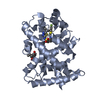
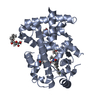

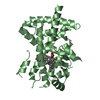

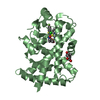

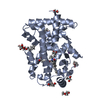
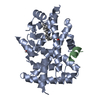

 PDBj
PDBj











